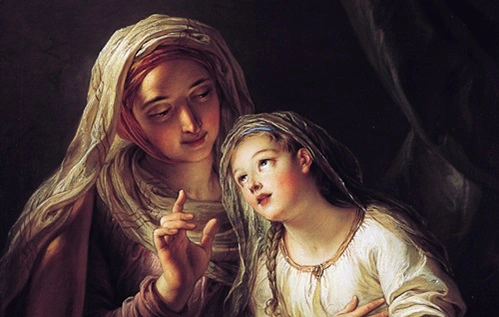Saint Anne, also known as Anne or Anna, is a significant figure in Christianity, revered as the mother of the Virgin Mary and the grandmother of Jesus Christ. While much of her life remains shrouded in mystery, she has become a symbol of motherhood, faith, and devotion across various cultures and denominations. Here are over 10 interesting facts about Saint Anne that highlight her importance in religious tradition and her enduring legacy.

1. Saint Anne’s Origins and Historical Context
Saint Anne is believed to have been born in Israel, likely in the region of Judea, during a time when the Jewish faith was prominent. While the Bible does not provide specific details about her life, her story is mainly derived from apocryphal texts, particularly the Protoevangelium of James, a second-century text that elaborates on Mary’s early life and parentage. This text portrays Saint Anne as a pious woman who longed for a child, showcasing her deep faith and devotion to God.
2. The Patroness of Mothers and Grandmothers
Saint Anne is widely recognized as the patron saint of mothers, grandmothers, and women in labor. Her association with motherhood stems from her role as the mother of Mary, who gave birth to Jesus. Many women seek her intercession during pregnancy and childbirth, believing that she offers protection and guidance. Churches dedicated to Saint Anne often feature her image in artwork, symbolizing the importance of maternal figures in the Christian faith.
3. Saint Anne’s Feast Day
Saint Anne’s feast day is celebrated on July 26 in the Western Christian tradition and on September 9 in the Eastern Orthodox Church. This day is observed with various religious ceremonies, including Masses, processions, and special prayers dedicated to her. In many communities, this feast day is an occasion for family gatherings and celebrations, emphasizing the importance of family and maternal bonds.
4. The Story of Anne and Joachim
According to the Protoevangelium of James, Saint Anne was married to Joachim, a wealthy and pious man. The couple struggled with infertility for many years, which was considered a source of shame in their culture. Anne and Joachim prayed fervently for a child, and an angel appeared to them, promising that they would conceive a daughter. This daughter would grow up to become the mother of the Messiah. This narrative underscores themes of hope, perseverance, and divine intervention.
5. The Iconography of Saint Anne
In religious art, Saint Anne is often depicted in various ways. One of the most common representations is her holding the infant Mary, showcasing the bond between mother and daughter. Additionally, she is sometimes shown teaching Mary, symbolizing the importance of maternal guidance in spiritual development. Iconography featuring Saint Anne reflects her role as a nurturing and wise figure, emphasizing the value of family and faith.
6. The Importance of Saint Anne in Catholicism
Saint Anne holds a special place in the hearts of Catholics around the world. The Catholic Church recognizes her as a saint, and numerous churches and shrines are dedicated to her. One of the most notable is the Basilica of Sainte-Anne-de-Beaupré in Quebec, Canada, which attracts thousands of pilgrims each year seeking her intercession. This shrine is renowned for miraculous healings and serves as a testament to the enduring devotion to Saint Anne.
7. Saint Anne’s Influence in Eastern Orthodoxy
In Eastern Orthodox Christianity, Saint Anne is also revered as a saint and is often honored alongside her husband, Saint Joachim. The Orthodox Church emphasizes her role in the story of salvation, recognizing her as the mother of Mary, who bore Christ. Iconography in the Orthodox tradition may depict Anne and Joachim together, highlighting the significance of their partnership in raising Mary and their role in divine history.
8. Miraculous Healings and Intercession
Many people believe in the miraculous intercession of Saint Anne, particularly in matters related to family, fertility, and motherhood. Numerous accounts of healings and answered prayers attributed to her intercession have been recorded throughout history. These stories inspire hope and faith among the faithful, reinforcing the belief that Saint Anne is a compassionate and powerful advocate before God.
9. Cultural Celebrations of Saint Anne
Saint Anne is celebrated in various cultures around the world, often with local customs and traditions. For example, in the Philippines, devotees celebrate the feast day of Saint Anne with vibrant processions and religious ceremonies. In some areas, it is customary to hold a novena (nine days of prayer) leading up to her feast day, reflecting the strong devotion to her among Filipino Catholics. Similar celebrations occur in Latin America and other regions where her influence is felt.
10. Saint Anne in Modern Times
In contemporary society, the legacy of Saint Anne continues to resonate with many. Her story serves as an inspiration for women facing challenges related to motherhood, fertility, and family life. Organizations dedicated to promoting women’s health and well-being often invoke her name and seek her guidance in their missions. Saint Anne’s life encourages individuals to cultivate hope, faith, and resilience in the face of adversity.
11. Her Role in Education and the Arts
Saint Anne’s influence extends to education and the arts, particularly in nurturing the next generation. She is often viewed as a symbol of wisdom and guidance, encouraging the values of learning and moral development. Educational institutions, especially those affiliated with Catholic traditions, may invoke her name as a patroness. Additionally, artists continue to find inspiration in her story, creating works that celebrate her legacy and role in the divine narrative.
12. The Universal Message of Saint Anne
The story of Saint Anne transcends religious boundaries and offers universal messages about love, sacrifice, and the importance of family. Her life exemplifies the virtues of patience and faith in God’s promises, resonating with individuals from diverse backgrounds. In a world where familial relationships and maternal figures are often central to personal growth and development, Saint Anne’s story remains relevant and meaningful.
Saint Anne’s legacy as the mother of Mary and grandmother of Jesus continues to inspire countless individuals around the world. Each of these interesting facts highlights her significance in Christianity, her enduring influence on culture, and the universal themes that emerge from her story. As a figure of motherhood, hope, and resilience, Saint Anne encourages us to cherish our families, cultivate our faith, and seek strength in times of need. Whether through prayer, devotion, or cultural celebration, her impact is felt across generations, making her a cherished saint in the hearts of many.


